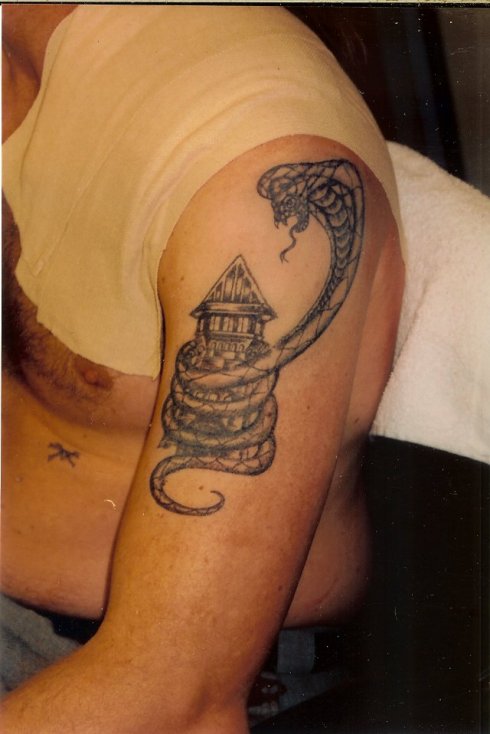Mens Tattoo Quotes Biography
Source(Google.com.pk)
The mens Tattoo etymological origin of the word ‘tattoo’ is believed to have two major derivations; the first is from the Polynesian word ta which means striking something and the second is the Tahitian word tatau which means ‘to mark something’. The use of tattoos is recorded to have begun thousands of years ago and its history is as varied, colorful and diverse as the people who carry them. From a simple scientific standpoint – tattoos are created the insertion of colored materials beneath the skins’ surface or epidermis. The first tattoos were most likely created unintentionally. Someone with a small wound or gash happened to rub it with a dirty hand that was covered with soot or ash. Once the wound had healed, they realized that the skin had healed over the ash and that the mark became a permanent addition.Our knowledge of tattooing in Europe really begins with the Ancient Greek and Roman historians. The only sources of information before this are archeological finds which are scare and, above all, open to interpretations. It is possible that tattooing cultures already existed in Europe before the last Great Ice Ace, 12,000 years ago. Bowls with traces of black and red pigments along with sharpened flint instruments were discovered in the Grotte des Fees (Fairy Grotto) in Chatelperron – France, 1867, and in caves in Portugal and Scandinavia. The shape and size of the tools suggest that they have been used for tattooing.Images of people decorated with what appear to be four tattooed horizontal lines on both sides of their noses have been found on prehistoric stone pillars in Aveyron and Tarn, France. Clay Cucuteni figures dating from 5,000 BC showing traces of tattoos have been found in the Romanian Danube region. Drawings and figurines discovered in a Thracian burial mound near Philippopolis may depict tattooed people, but considering the complexity of the decorations it is more likely that these represent body painting or finely worked figurines.The main reason for the disappearance of ancient traditions in many places was the ending of their almost total isolation. After centuries of living as more or less equivalent cultures indigenous populations were overwhelmed by the dominant European seafaring nations. The technological and militarily superior Europeans introduced their own value systems based on Christian beliefs. Like the Greeks and the Chinese before them the Europeans disdained the practices of the inhabitants of the newly discovered regions. It could not have escaped the notice of the natives that many of the mainly male adventurers found the permanent body decorations of the ‘otherwise so attractive’ women disdainful. Similarly, many Greenland Inuit women rejected the traditional facial tattoos, fearing that mainland men would find them unattractive.In 1991, ‘Otzi the Ice Man’ made the headlines of newspapers all over the world when his frozen body was discovered on a mountain between Austria and Italy. This is the best preserved corpse of that period ever found. The skin bears 57 tattoos: a cross on the inside of the left knee, six straight lines 15 centimeters long above the kidneys and numerous parallel lines on the ankles. For centuries the Berbers in mountainous regions of North Africa used this kind of therapeutic tattoo to treat rheumatic pains. Anthropologists believe a traditional healer made incisions in Otzi’s skin on the afflicted areas, placing medicinal herbs in the wound which were burnede with the point of a heated metal instrument. The charred residue was incorporated in the resulting scar. An examination of Otzi’s tattooed skin tissue revealed that the scares to contain carbon particles. Probably a shepherd or hunter, he was middle aged at the time of his death. The copper ace found with him suggests he was a man of some distinction. Otzi, named after the Oztal where he was found, lived 5,300 years ago. He was probably murdered as an arrowhead was found in his back and his body shows traces of cuts and deep bruising. Encased in ice for thousands of years, Otzi and the objext found with him are remarkably well preserved.In 1948 – just over 200 kilometers North of the borders between Russia and China – Russian archeologist Sergei Rudenko began excavating a group of tombs, or Kurgans, in the high Altai mountains. At this site mummies, that date from around 2,400 years ago, were excavated. On their bodies were a wide array of tattoos said to represent various indigenous and mythological animals. Amongst them were griffins and monsters that were thought to have a magical significance yet some of these kinds of elements are believed to be purely aesthetic, decorative or ornamental. The tattoos of these mummies, when viewed together or as a whole piece, were believed to reflect the status of the individual bearing them.
Source(Google.com.pk)
The mens Tattoo etymological origin of the word ‘tattoo’ is believed to have two major derivations; the first is from the Polynesian word ta which means striking something and the second is the Tahitian word tatau which means ‘to mark something’. The use of tattoos is recorded to have begun thousands of years ago and its history is as varied, colorful and diverse as the people who carry them. From a simple scientific standpoint – tattoos are created the insertion of colored materials beneath the skins’ surface or epidermis. The first tattoos were most likely created unintentionally. Someone with a small wound or gash happened to rub it with a dirty hand that was covered with soot or ash. Once the wound had healed, they realized that the skin had healed over the ash and that the mark became a permanent addition.Our knowledge of tattooing in Europe really begins with the Ancient Greek and Roman historians. The only sources of information before this are archeological finds which are scare and, above all, open to interpretations. It is possible that tattooing cultures already existed in Europe before the last Great Ice Ace, 12,000 years ago. Bowls with traces of black and red pigments along with sharpened flint instruments were discovered in the Grotte des Fees (Fairy Grotto) in Chatelperron – France, 1867, and in caves in Portugal and Scandinavia. The shape and size of the tools suggest that they have been used for tattooing.Images of people decorated with what appear to be four tattooed horizontal lines on both sides of their noses have been found on prehistoric stone pillars in Aveyron and Tarn, France. Clay Cucuteni figures dating from 5,000 BC showing traces of tattoos have been found in the Romanian Danube region. Drawings and figurines discovered in a Thracian burial mound near Philippopolis may depict tattooed people, but considering the complexity of the decorations it is more likely that these represent body painting or finely worked figurines.The main reason for the disappearance of ancient traditions in many places was the ending of their almost total isolation. After centuries of living as more or less equivalent cultures indigenous populations were overwhelmed by the dominant European seafaring nations. The technological and militarily superior Europeans introduced their own value systems based on Christian beliefs. Like the Greeks and the Chinese before them the Europeans disdained the practices of the inhabitants of the newly discovered regions. It could not have escaped the notice of the natives that many of the mainly male adventurers found the permanent body decorations of the ‘otherwise so attractive’ women disdainful. Similarly, many Greenland Inuit women rejected the traditional facial tattoos, fearing that mainland men would find them unattractive.In 1991, ‘Otzi the Ice Man’ made the headlines of newspapers all over the world when his frozen body was discovered on a mountain between Austria and Italy. This is the best preserved corpse of that period ever found. The skin bears 57 tattoos: a cross on the inside of the left knee, six straight lines 15 centimeters long above the kidneys and numerous parallel lines on the ankles. For centuries the Berbers in mountainous regions of North Africa used this kind of therapeutic tattoo to treat rheumatic pains. Anthropologists believe a traditional healer made incisions in Otzi’s skin on the afflicted areas, placing medicinal herbs in the wound which were burnede with the point of a heated metal instrument. The charred residue was incorporated in the resulting scar. An examination of Otzi’s tattooed skin tissue revealed that the scares to contain carbon particles. Probably a shepherd or hunter, he was middle aged at the time of his death. The copper ace found with him suggests he was a man of some distinction. Otzi, named after the Oztal where he was found, lived 5,300 years ago. He was probably murdered as an arrowhead was found in his back and his body shows traces of cuts and deep bruising. Encased in ice for thousands of years, Otzi and the objext found with him are remarkably well preserved.In 1948 – just over 200 kilometers North of the borders between Russia and China – Russian archeologist Sergei Rudenko began excavating a group of tombs, or Kurgans, in the high Altai mountains. At this site mummies, that date from around 2,400 years ago, were excavated. On their bodies were a wide array of tattoos said to represent various indigenous and mythological animals. Amongst them were griffins and monsters that were thought to have a magical significance yet some of these kinds of elements are believed to be purely aesthetic, decorative or ornamental. The tattoos of these mummies, when viewed together or as a whole piece, were believed to reflect the status of the individual bearing them.
Mens Tattoo Quotes
Mens Tattoo Quotes
Mens Tattoo Quotes
Mens Tattoo Quotes
Mens Tattoo Quotes
Mens Tattoo Quotes
Mens Tattoo Quotes
Mens Tattoo Quotes
Mens Tattoo Quotes
Mens Tattoo Quotes










No comments:
Post a Comment